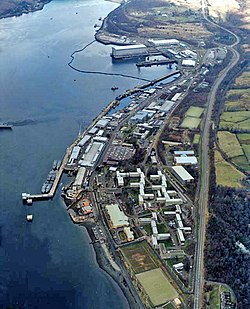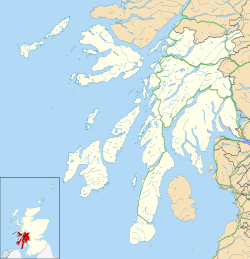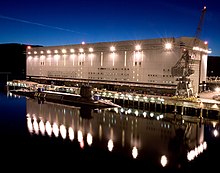
The Royal Navy (RN) is the United Kingdom's naval warfare force and a component of His Majesty's Naval Service. Although warships were used by English and Scottish kings from the early medieval period, the first major maritime engagements were fought in the Hundred Years' War against France. The modern Royal Navy traces its origins to the early 16th century; the oldest of the UK's armed services, it is consequently known as the Senior Service.

HMS Astute is an operational nuclear-powered attack submarine in the Royal Navy, the lead boat of her class.

The Holy Loch is a sea loch, a part of the Cowal peninsula coast of the Firth of Clyde, in Argyll and Bute, Scotland.
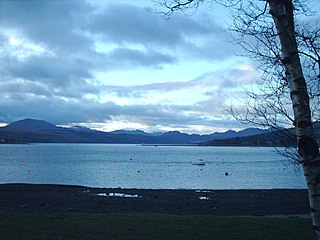
The Gare Loch or Gareloch is an open sea loch in Argyll and Bute, Scotland and bears a similar name to the village of Gairloch in the north west Highlands.

The River class is a class of offshore patrol vessels built primarily for the Royal Navy of the United Kingdom. A total of nine were built for the Royal Navy (RN), four Batch 1 and five Batch 2. One Batch 1 (HMS Clyde), which was the Falklands guard ship, was decommissioned and transferred at the end of its lease to the Royal Bahrain Naval Force.

Standing Royal Navy deployments is a list of operations and commitments undertaken by the United Kingdom's Royal Navy on a worldwide basis. The following list details these commitments and deployments sorted by region and in alphabetical order. Routine deployments made by the Navy's nuclear-powered submarines and their location of operations is classified.

The eleventh HMS Vanguard of the Royal Navy is the lead boat of her class of Trident ballistic missile-armed submarines. The submarine is based at Faslane, HMNB Clyde, Argyll, Scotland.

The latest HMS Warspite was the third of Britain's nuclear-powered submarines, and the second of the Valiant class. After entering service in 1967 she collided with a Soviet submarine the following year. A mechanical failure associated with the submarine's nuclear reactor in 1991 led to the boat being laid up at HMNB Devonport where she awaits disposal.
A submarine squadron (SUBRON) is a naval formation or unit in such states such as the United Kingdom, United States, and Russia/Soviet Union. In France the equivalent unit is the escadrille des sous-marins nucléaires d'attaque (ESNA), part of the French submarine forces.

The Commander-in-Chief Fleet (CINCFLEET) was the admiral responsible for the operations of the ships, submarines and aircraft of the British Royal Navy from 1971 until April 2012. The post was subordinate to the First Sea Lord, the professional head of the Naval Service. In its last years, as the Navy shrank, more administrative responsibilities were added.

His Majesty's Naval Service is the United Kingdom's naval warfare and maritime service. It consists of the Royal Navy, Royal Marines, Royal Fleet Auxiliary, Royal Naval Reserve, Royal Marines Reserve and Naval Careers Service. The Naval Service as a whole falls under the command of the Navy Board, which is headed by the First Sea Lord. This position is currently held by Admiral Sir Ben Key. The Defence Council delegates administration of the Naval Service to the Admiralty Board, chaired by the Secretary of State for Defence.

HMS Tracker is an Archer-class (P2000) patrol and training vessel of the British Royal Navy. Along with the batch 2 Archer class, HMS Raider, Tracker is part of the Faslane Patrol Boat Squadron based at HMNB Clyde.
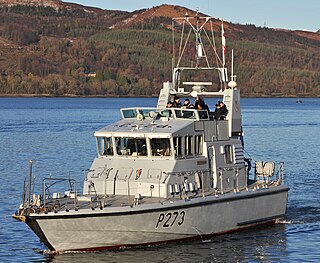
HMS Pursuer is an Archer-class P2000 patrol and training vessel of the Royal Navy.
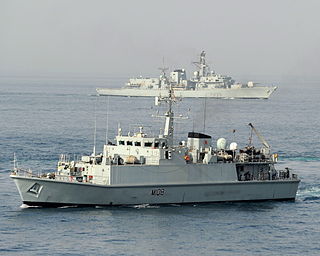
HMS Grimsby was a Sandown-class minehunter of the British Royal Navy, serving from 1999–2022, and the second ship to bear the name.

The Archer class is a class of patrol and training vessel in service with the United Kingdom's Royal Navy, commonly referred to as a "fast training boat". Most are assigned to Coastal Forces Squadron. HMS Tracker and HMS Raider are armed and provide maritime force protection to high value shipping in the Firth of Clyde and are most commonly employed as escorts for submarines transiting to Faslane. Pursuer and Dasher were also armed during their deployment on maritime force protection duties with the Gibraltar Squadron from 2020-2022.

HMS Dasher is an Archer-class P2000 patrol and training vessel of the British Royal Navy. Dasher was built at Vosper Thorneycroft and commissioned in 1988.
In 1989 the Royal Navy was under the direction of the Navy Department in the UK Ministry of Defence. It had two main commands, CINCFLEET and Naval Home Command.

This is a list of active military units, bases and barracks of the British Armed Forces in Scotland. The armed forces in Scotland include the military bases and organisation in Scotland or associated with Scotland. This includes servicemen and women from Scotland and Scottish regiments and brigades. The Military in Scotland includes the three services. The Army which has bases across Scotland, the RAF and the Navy.
